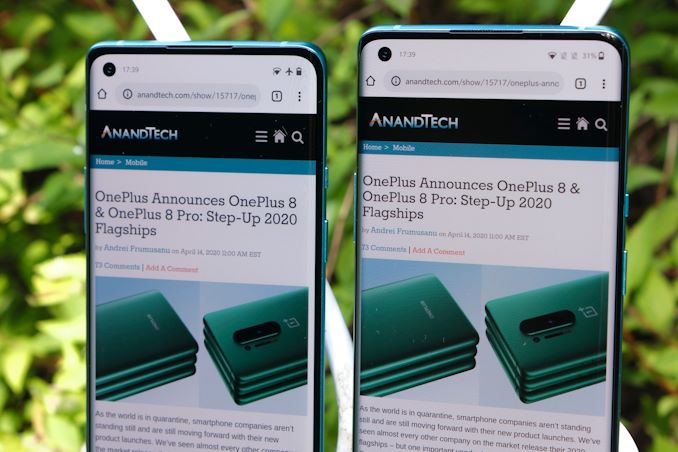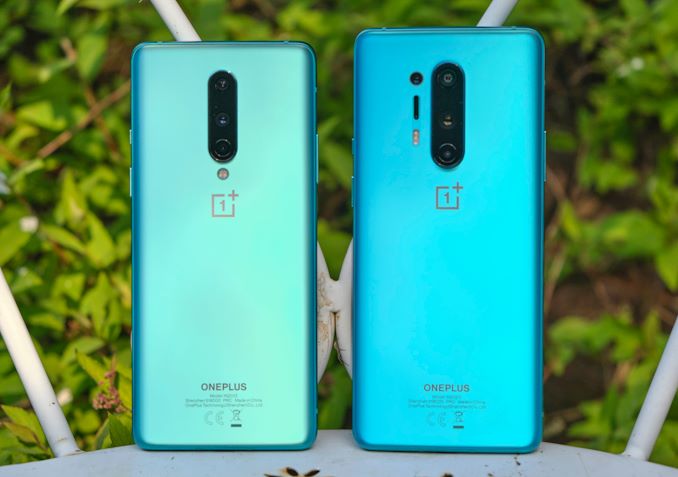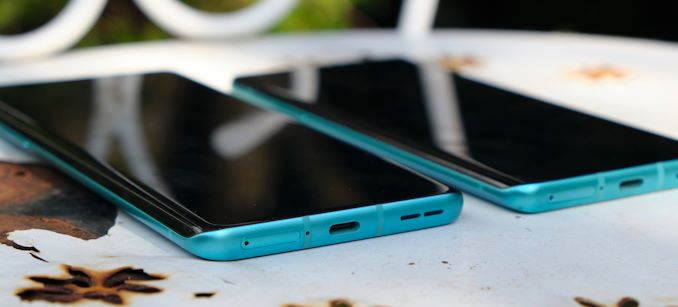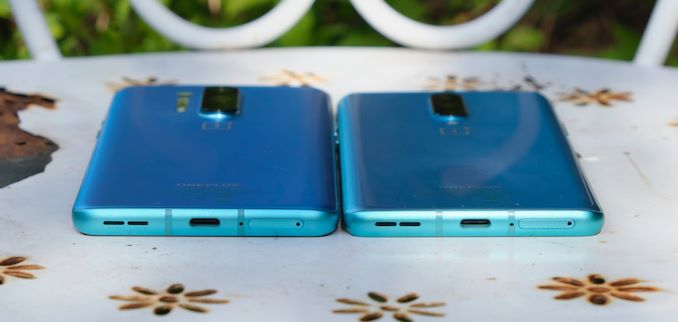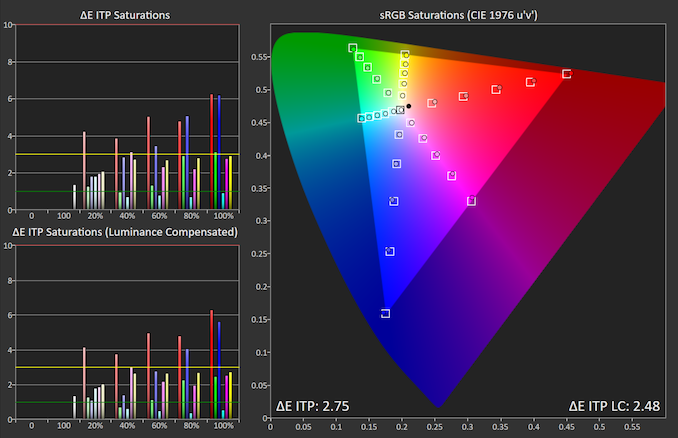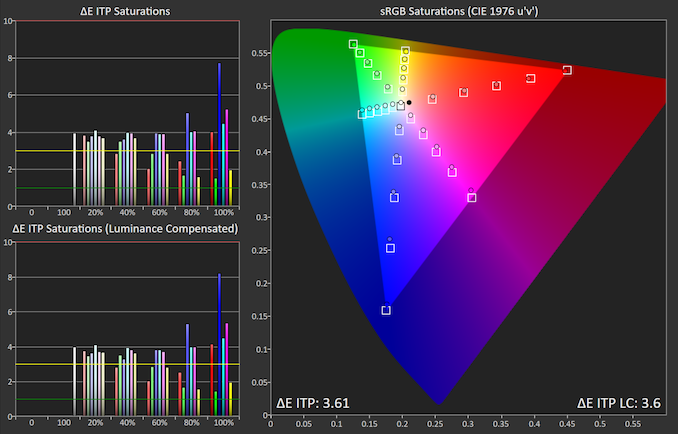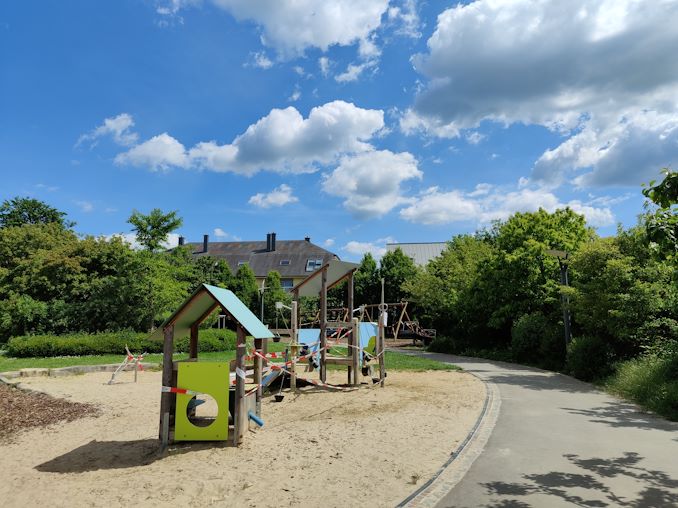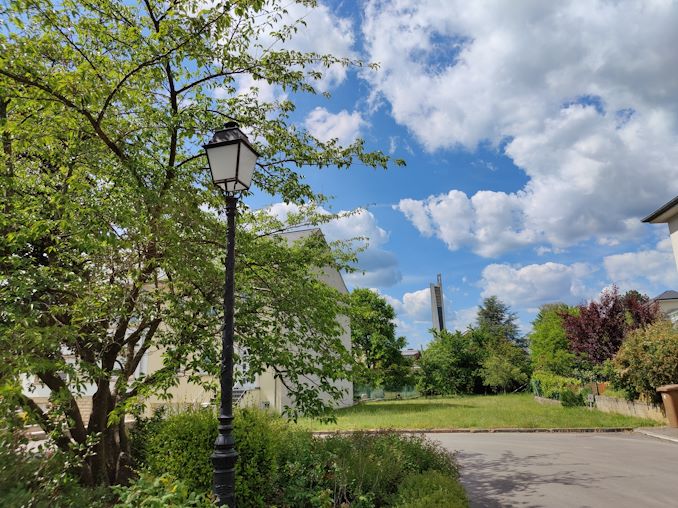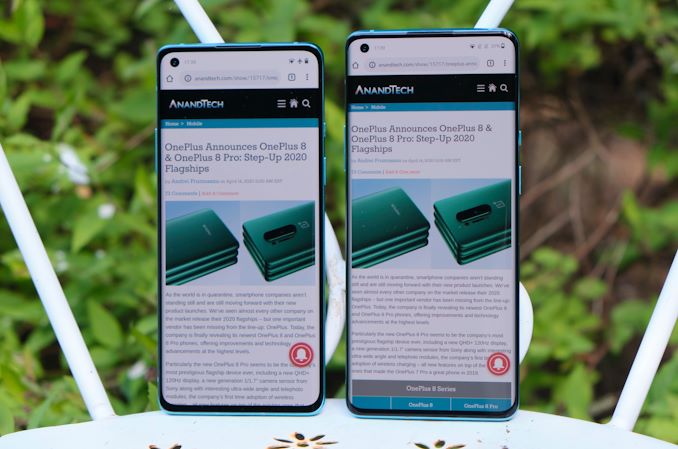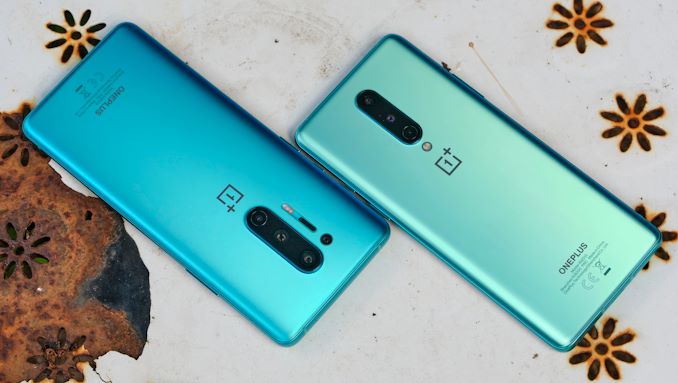
Original Link: https://www.anandtech.com/show/15883/the-oneplus-8-oneplus-8-pro-pro-review-becoming-the-flagship
The OnePlus 8, OnePlus 8 Pro Review: Becoming The Flagship
by Andrei Frumusanu on June 29, 2020 10:00 AM EST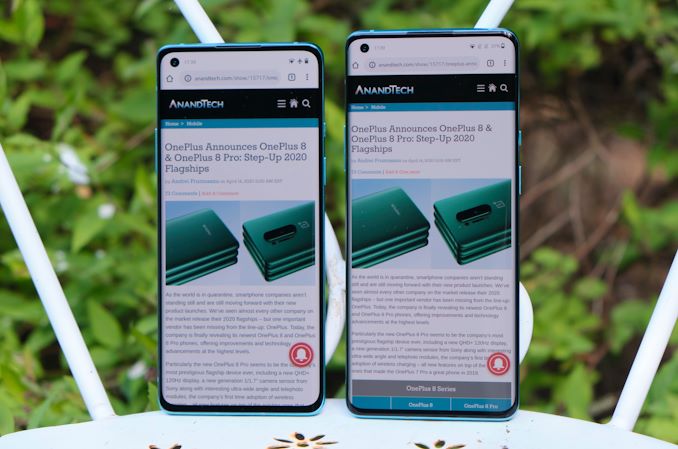
It’s been a couple of months since OnePlus released the new OnePlus 8 & OnePlus 8 Pro, and both devices have received plenty of software updates improving the device’s experiences and camera qualities. Today, it’s time to finally go over the full review of both devices, which OnePlus no longer really calls “flagship killers”, but rather outright flagships.
The OnePlus 8, and especially the OnePlus 8 pro are big step-up redesigns from the company, significantly raising the bar in regards to the specifications and features of the phones. The OnePlus 8 Pro is essentially a check-marked wish-list of characteristics that were missing from last year’s OnePlus 7 Pro as the company has addressed some of its predecessors’ biggest criticisms. The slightly smaller and cheaper regular OnePlus 8 more closely follows its predecessors’ ethos as well as competitive pricing, all whilst adopting the new design language that’s been updated with this year’s devices.
| OnePlus 8 Series | ||
| OnePlus 8 | OnePlus 8 Pro | |
| SoC | Qualcomm Snapdragon 865 1x Cortex-A77 @ 2.84GHz 3x Cortex-A77 @ 2.42GHz 4x Cortex-A55 @ 1.80GHz Adreno 640 @ 587MHz |
|
| Display | 6.55-inch FHD+ 2400 x 1080 (20:9) 90Hz Refresh Rate |
6.78-inch QHD+ 3160 x 1440 (19.8:9) 120Hz Refresh Rate |
| SAMOLED HDR10+ |
||
| Dimensions | 160.2 x 72.9 x 8.0 mm 180 grams |
165.3 x 74.4 x 8.8 mm 199 grams |
| RAM | 8/12GB LPDDR4X | 8/12GB LPDDR5 |
| NAND Storage |
128/256 GB UFS 3.0 | |
| Battery | 4300mAh (16.55Wh) typ. | 4510mAh (17.36Wh) typ. |
| 30W Fast Charging | ||
| - | 30W Wireless Fast Charging (only via proprietary charger) 5W Qi Wireless Charging |
|
| Front Camera | 16MP f/2.0 |
16MP f/2.4 |
| Primary Rear Camera | 48MP 0.8µm 1/2" IMX586 (12MP 1.6µm 2x2 binning) f/1.75 w/ OIS |
48MP 1.12µm 1/1.4" IMX689 (12MP 2.24µm 2x2 binning) f/1.78 w/ OIS |
| Secondary Rear Camera |
16MP Ultra-Wide-Angle f/2.2 116° FoV |
48MP Ultra-Wide-Angle f/2.2 120° FoV |
| Tertiary Rear Camera |
2MP Macro Camera f/2.4 |
8MP Telephoto f/2.4 |
| Extra Camera |
- | 5MP Colour Sensor f/2.4 |
| 4G / 5G Modem |
Snapdragon 5G - Snapdragon Modem X55 (Discrete) (LTE Category 24/22) DL = 2500 Mbps - 7x20MHz CA, 1024-QAM UL = 316 Mbps 3x20MHz CA, 256-QAM (5G NR Sub-6) DL = 7000 Mbps UL = 3000 Mbps mmWave for OnePlus 8 (non-Pro) on Verizon in the US |
|
| SIM Size | NanoSIM + NanoSIM | |
| Wireless | 802.11a/b/g/n/ac/ax BT 5.1 LE, NFC, GPS/Glonass/Galileo/BDS |
|
| Connectivity | USB Type-C no 3.5mm jack |
|
| Special Features | On-screen fingerprint sensor, Stereo Speakers |
|
| IP68 Rating | ||
| Launch OS | Android 10 w/ Oxygen OS | |
| Launch Prices | 8+128GB: $699 / 699€ 12+256GB: $799 / 799€ |
8+128GB: $899 / 899€ 12+256GB: $999 / 999€ |
Starting off with the specs, both phones are powered by Qualcomm’s newest Snapdragon 865 SoC, which means they’ll be both delivering amongst the best performance and experience that one can have on an Android device today. One notable difference in the hardware specifications is that the regular OnePlus 8 comes with 8/12GB of LPDDR4X whilst the 8 Pro comes with 8/12GB of newer LPDDR5X. It’s an interesting choice, but we’ll see that the actual end result in performance and efficiency isn’t exactly what you would have expected, and is actually negligible. OnePlus is configuring both phones with either 128 or 256GB of UFS 3.0 storage.
The phones’ key characteristics is their new screens. The big change for the regular OnePlus 8 is the fact that it now adds a 90Hz refresh rate to its 2400 x 1080 OLED screen, a feature previously only present on the Pro model. Essentially this brings the high-refresh rate feature down in the product stack, something we’ve even seen from other vendors in the high-mid-end or “premium” stack.
The bigger OnePlus 8 Pro naturally has to one-up this, and it’s 3160 x 1440 OLED screen is now capable of a 120Hz refresh rate. The big difference for the 8 Pro versus other 120Hz contenders such as the Galaxy S20 series is the fact that OnePlus allows this refresh rate at the full native QHD resolution of the panel, whilst Samsung is forcing users to choose between 120Hz and 1440p resolution.
The regular OnePlus 8 comes with a 6.55” diagonal screen whilst the 8 Pro has a slightly larger 6.78” form-factor and that’s a key differentiating factor for the two devices’ footprints.
One big generational change in the design of the phones is in the front camera setup. Both phones now feature a left corner positioned hole cut-out for the front camera. The diameter of the cut-out isn’t all too different to what we’re seeing on the S20 series, but I find the corner placement to be maybe less intrusive, and it also allows OnePlus to actually house a much better (stereo) designed earpiece speaker compared to the S20’s series.
Some people were a fan of the mechanical pop-up camera of the OnePlus 7 Pro, but I was never really convinced by it given the technical compromises the phone had to make, especially in regards to thickness and weight. The OnePlus 8 Pro now is able to use this reclaimed space for internal components, a bigger battery, IP68 rating, all whilst even being lighter than the OnePlus 7 Pro – good riddance to the pop-up camera.
The rears of the phones retain the company’s “signature” central vertical camera setup which is actually something rare to see in 2020 as most other manufacturers have opted for a corner camera module layout, in this regard, even though OnePlus didn’t change anything, they do stick out.
The regular OnePlus 8 comes with a triple-camera setup amongst which there’s only two “real” daily usable modules. The main camera sensor here is the same as we’ve found on the OnePlus 7 series in the form of an 48MP IMX586, accompanied by a 16MP ultra-wide-angle module. The third camera is a dedicated 2MP macro module.
The OnePlus 8 Pro significantly upgrades the camera capabilities and here it’s where the phone outright competes with the best flagship devices on the market. The new main camera sensor is still 48MP, however this is a new IMX689 in a larger 1/1.4” sensor format – meaning the pixel pitch increases from 0.8µm to 1.12µm, effectively more than doubling the per-pixel and sensor area, as well as doubling the light gathering ability of the sensor.
The ultra-wide-angle module is also significantly upgraded – it’s now actually using the same 48MP sensor that the OnePlus 7 series and OnePlus 8 use for their main cameras, making the 8 Pro’s UWA amongst the highest specced on the market right now.
The 8 Pro has a quad-camera setup, 3 of which are usable in daily photography. The third module is the same 3x telephoto camera we’ve seen on the OnePlus 7 Pro. The fourth camera is a 5MP “colour filter module” which essentially is a regular camera with the IR filter removed, meaning it can capture IR wavelengths which can result in unique looking pictures, especially in sunlight.
One aspect I wanted to talk a bit more was the ergonomics of the phones, particularly their respective sizes as well as different screen curvature designs.
The first time I unpacked the regular OnePlus 8 out of its box and held it I had something akin to a revelation, as the phone outright felt as amongst the most perfect form-factors and ergonomics I’ve felt in a device in years. The phone felt incredibly premium – and although we’ve had glass sandwiches for years, this was by far the best feeling glass sandwich to date.
Holding the bigger OnePlus 8 Pro didn’t quite have the same response. Beyond it being a bit bigger which is subjective, the phone’s curves just weren’t as smooth. The big difference between the two units here is that the 8 Pro’s display glass curves to the sides with a much larger radius than the OnePlus 8.
Looking at both phones from the sides it’s obvious that the OnePlus 8 Pro’s metal side-frame isn’t actually centred, but actually more recessed towards the back of the phone. This makes it have a smaller back glass curvature compared to the regular OnePlus 8, and I think that this makes for quite a big difference in the ergonomics of the two phones.
We’ve had a lot of vendors experiment with curved front glass designs, ranging from the more conservative to more absurd 90° curves. Samsung most notably has toned down the front glass curvature on the S20 series and it’s actually been an improvement in the usability and feel of the phone. I think the OnePlus 8 Pro here also has a similar issue in that its front glass is too curved, whilst the OnePlus 8’s symmetric curves feel essentially perfect in-hand.
A form-factor difference between the two phones besides the footprint, is that the OnePlus 8 Pro is 0.8mm thicker. This doesn’t sound much, but it’s actually 10% difference between the two units and is immediately noticeable if you hold them side-by-side, but it’s not a major draw-back by its own. The 8 Pro is able to house a bigger 4510mAh battery, a slight bump over the 4300mAh unit of the regular OnePlus 8.
The camera bump on the 8 Pro is also slightly bigger than the one on the 8. It is sort of noticeable as the metal lip is protruding a lot more – however I found that given its central location on the phone I didn’t actually touch it all too often. Oh – and because the cameras are centred, it means the phone don’t wobble on a flat surface – something which is again a problem for most other 2020 devices.
The two sample units I received were “Glacial Green” flavours, although in pretty much in a lot of lightning conditions these actually appear as light blue. OnePlus’ usage of frosted matte glass textures on the back of the phones in this flavour makes this the no-brainer colour choice as it really augments the feeling of the device compared to the other glossy finishes.
Overall, I think OnePlus did excellently in terms of the design of the two phones. I was particularly enamoured with the regular OnePlus 8 as its form-factor and ergonomics are essentially the best I’ve felt in a phone in a very long time.
System Performance
System performance of the new OnePlus 8 phones shouldn’t be a big concern given the Snapdragon 865 chipsets as well as the fact that both phones have high-refresh rate displays. Still, software can play a big role in the experience of a device, so let’s look at our typical system performance benchmark suite:
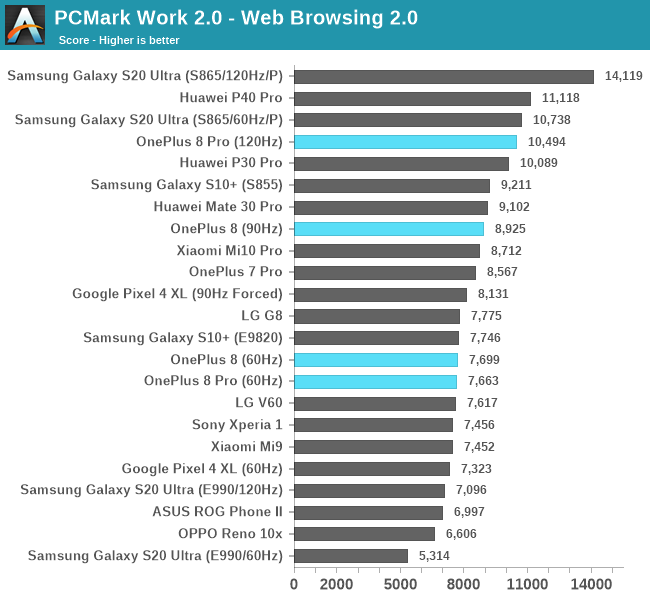
The web-browsing workload is a little bit lighter in terms of load, and is most sensitive to the actual performance responsiveness of a device’s scheduler. The OnePlus 8 phones in their regular 60Hz mode don’t seem to be all that convincing as they’re seemingly tuned to be more conservative than most other phones on the market. Increasing the refresh rate to respectively 90Hz and 120Hz ups the scores, but still not quite as high as what other phones are achieving.
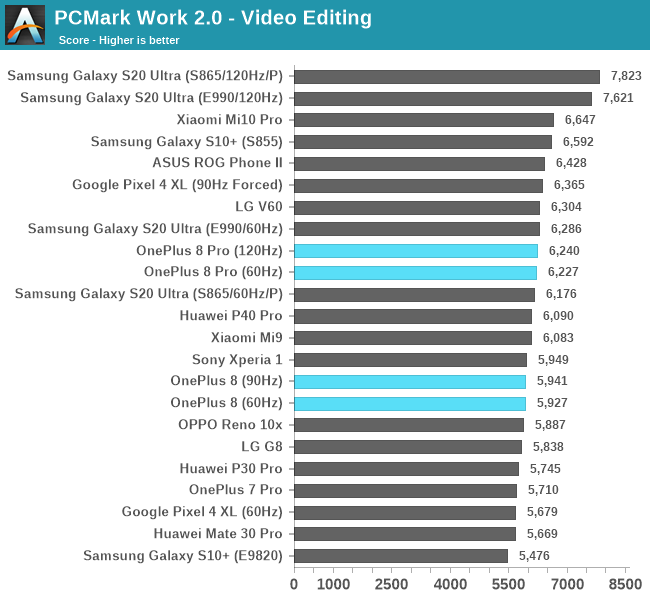
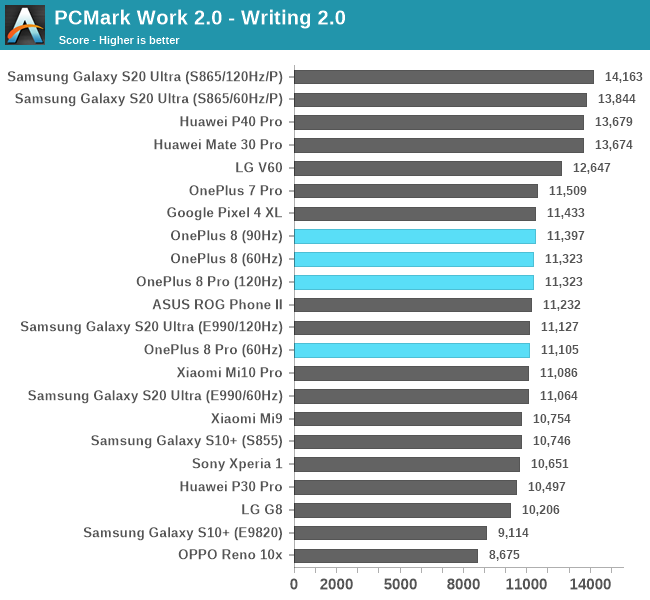
The writing sub-test of PCMark is the most representative of a device’s performance and how it will compare in the real world. Here the OnePlus 8 phones also fare relatively average in their rankings. Amongst the Snapdragon 865 devices it’s on par with the Xiaomi Mi10 Pro, but lose out to the LG V60 and particularly the Samsung S20 Ultra which has a considerable lead. Samsung usually tunes their BSP software more than other vendors and this can be seen here in particular.
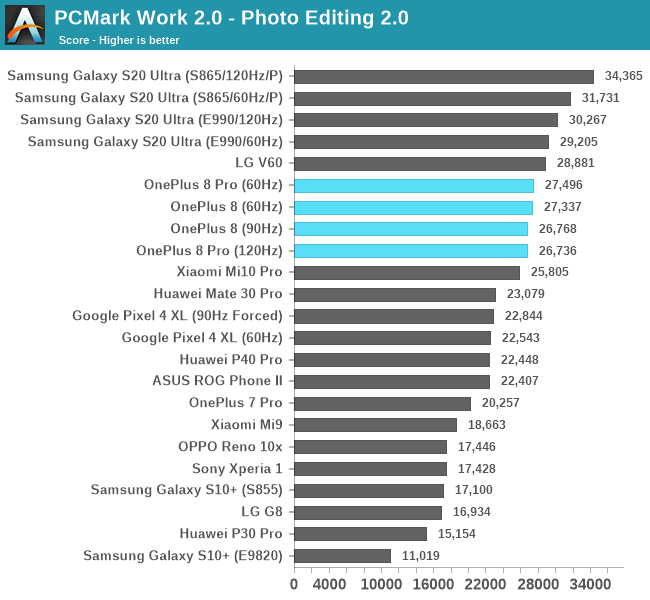
In the GPU-bound Renderscript photo editing test we see a similar ranking, the new generation devices are the top scoring phones but the OnePlus 8 falls a bit short of the V60 and S20.
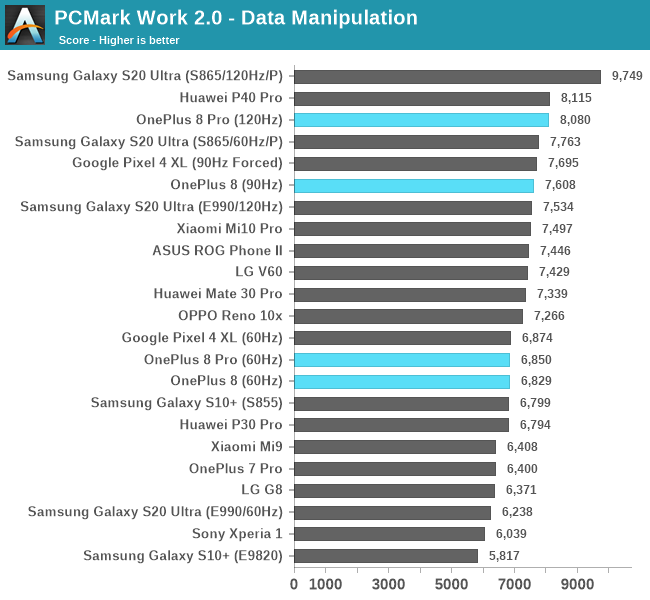
The data manipulation score is also very sensitive to performance scaling speed – at 60Hz the OnePlus devices aren’t particularly noteworthy, but at 90/120Hz they more closely match up the top performing devices.
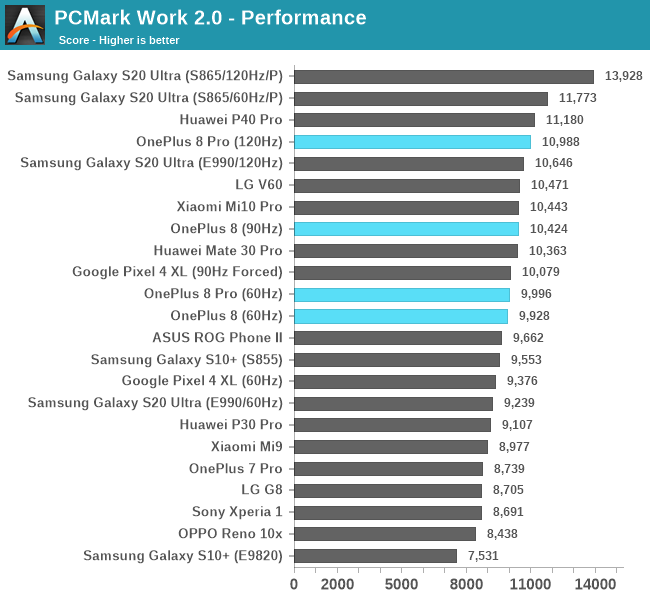
Overall, in the PCMark ranking the OnePlus 8 phones do well, although there’s a lot of other phones which seem to have more aggressive scheduler settings that are able to distance themselves more from the pack, in particular Samsung’s S20 series with the Snapdragon 865.
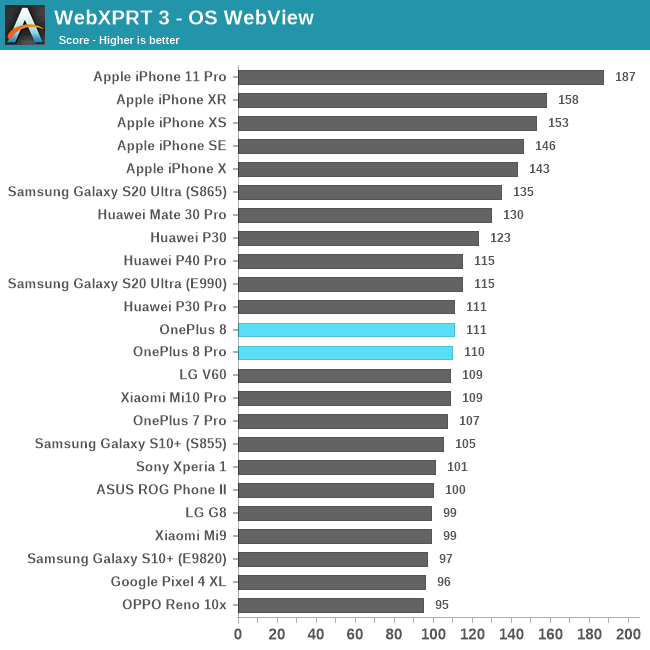
In the browser based benchmarks, we again see that the OnePlus 8 phones generally fall in line with other phones of its generation such as the V60 and the Mi 10 Pro, however fall short of the performance that the S20 is able to achieve.
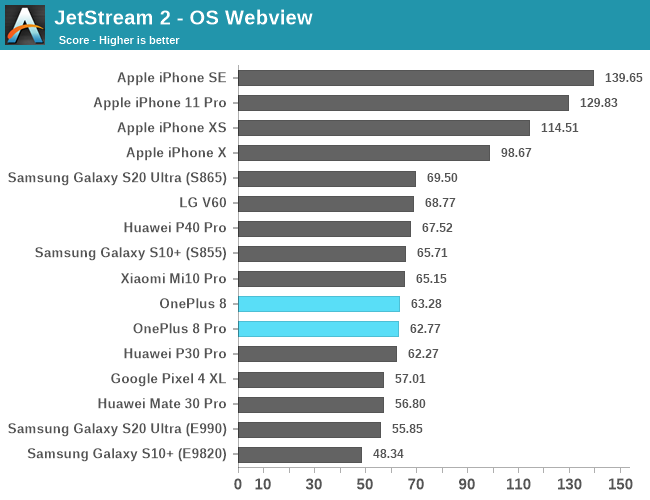
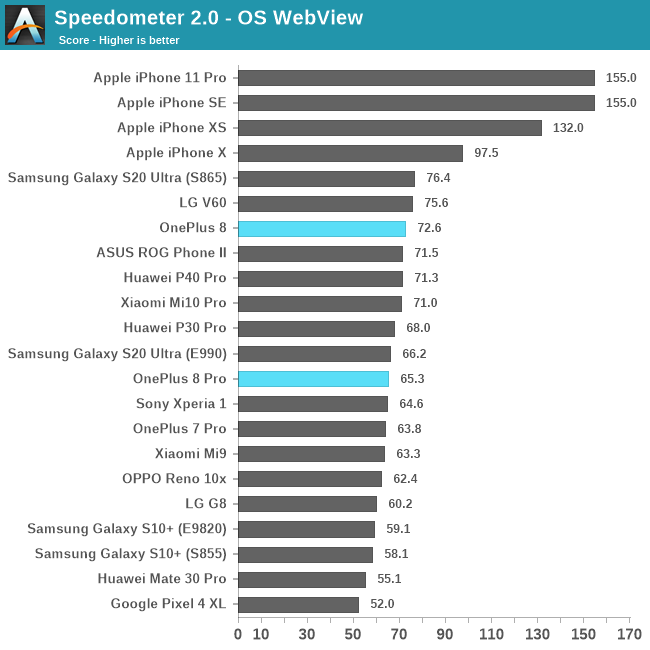
The Speedometer scores were quite odd in that I measured a bigger difference in performance between the two phones, with the regular OnePlus 8 for some reason being in the lead. I don’t have any good explanation for this other than possibly we’re seeing differences in the memory architectures of the two units and the benchmark is maybe exposing some sensitivities between the two units.
I had run my memory benchmarks on the two phones as this was the first time we’ve had access to an LPDDR4X version of the Snapdragon 865. The results were mixed – full random memory access latency was better on the LP5 system by about 5ns, but some other access patterns were slightly lower latency on the LP4 system. Sequential memory latency access in particular being oddly 10% lower latency on the LP4 system. Memory bandwidth wise, the LP5 system had a clear win with a 21% lead in memory reads at 35.71GB/s vs 29.31GB/s – however it lost on memory writes at 19.84GB/s vs 20.56GB/s in favour of the LP4 system. In actual memory copy loads it was thus also the LP4 system which had a notable lead of 12% at 10.22GB/s vs 9.09GB/s.
These are all results I hadn’t quite expected and shows that the newer memory technology doesn’t necessarily mean it’s outright better in every regard. The difference here in the Speedometer test could be very much tied to one of the memory performance characteristics of the systems
Overall Performance Verdict
Although the OnePlus 8 phones didn’t particularly top the benchmark scores in our system tests, they still showcase outstanding experiences in the real world. The 90Hz refresh rate on the OnePlus 8 is very much noticeable and a great addition to the product, and the 120Hz scrolling experience of the OnePlus 8 Pro even exceeds it.
I tried hard to compare the OnePlus 8 Pro to Samsung’s S20 series phones, and whilst the differences were minute, Samsung’s devices did seem just a little bit snappier and that fact does materialise in our benchmark scores. It’s possible here that OnePlus opted to leave the more conservative DVFS and scheduler tuneables at the Qualcomm defaults for a more balanced battery life experience.
Still – you can’t go wrong either OnePlus phone as both are exemplary in their performance characteristics.
GPU Performance
GPU performance of the new OnePlus 8 devices should be interesting as we finally have more Snapdragon 865 platforms at hand to test, beyond the initial Galaxy S20 scores that we were able to showcase a few months ago.
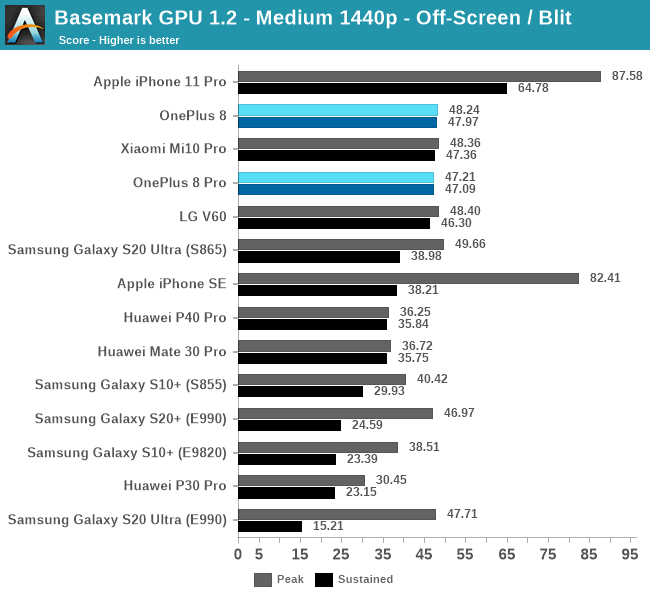
Starting off with BaseMark GPU 1.2, we’re seeing some very good results from both OnePlus 8 phones. Although peak performance is just a tad little bit lower than the Galaxy S20 Ultra, both OnePlus phones are able to showcase much better sustained performance figures with essentially no throttling after prolonged usage.
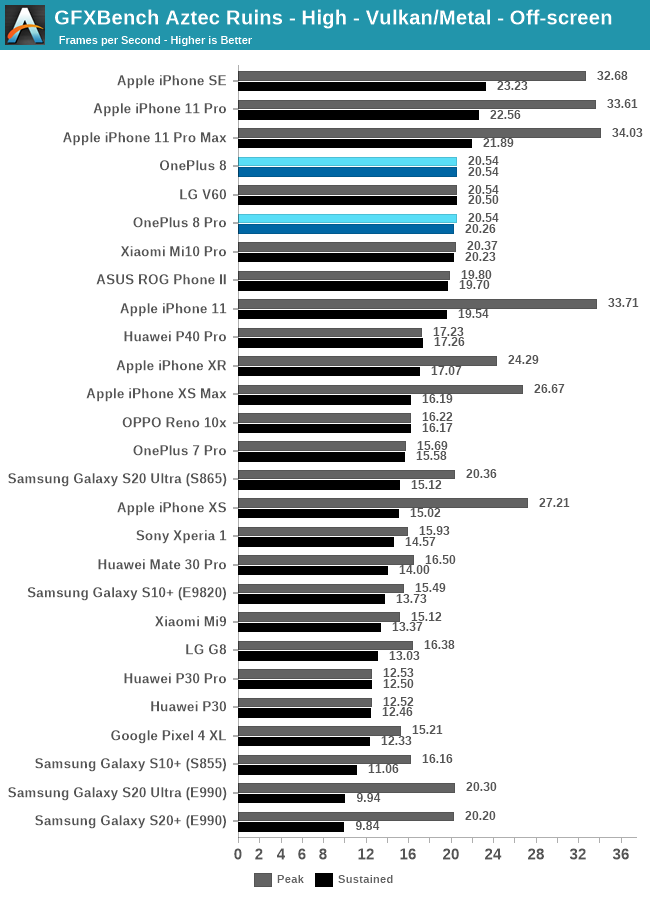
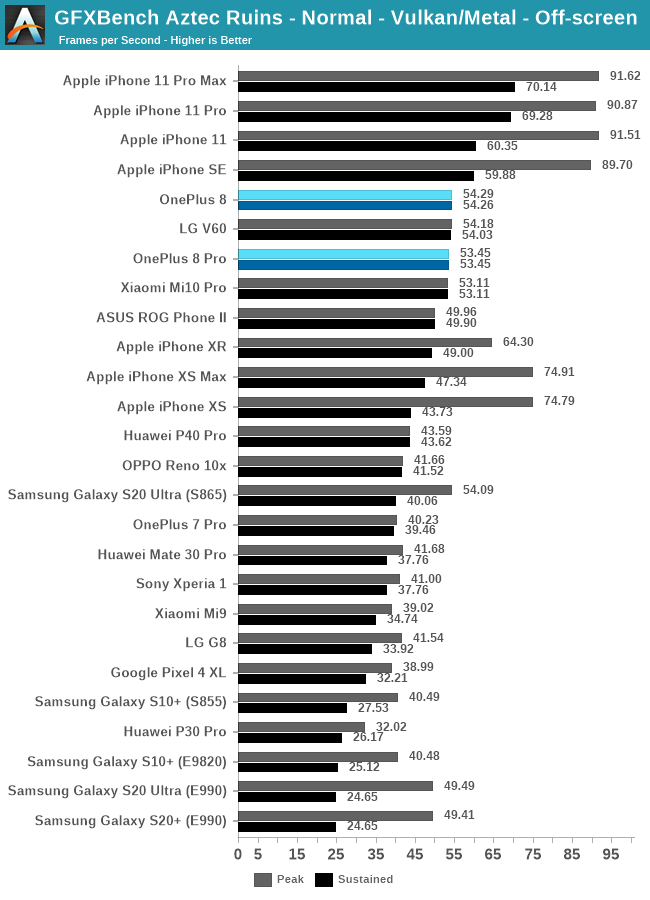
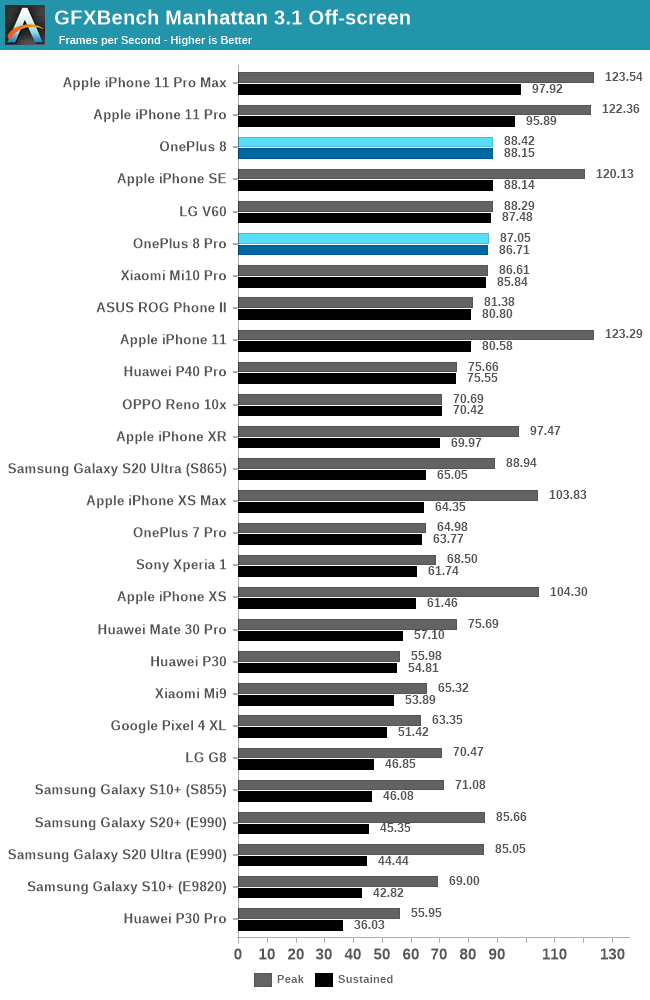
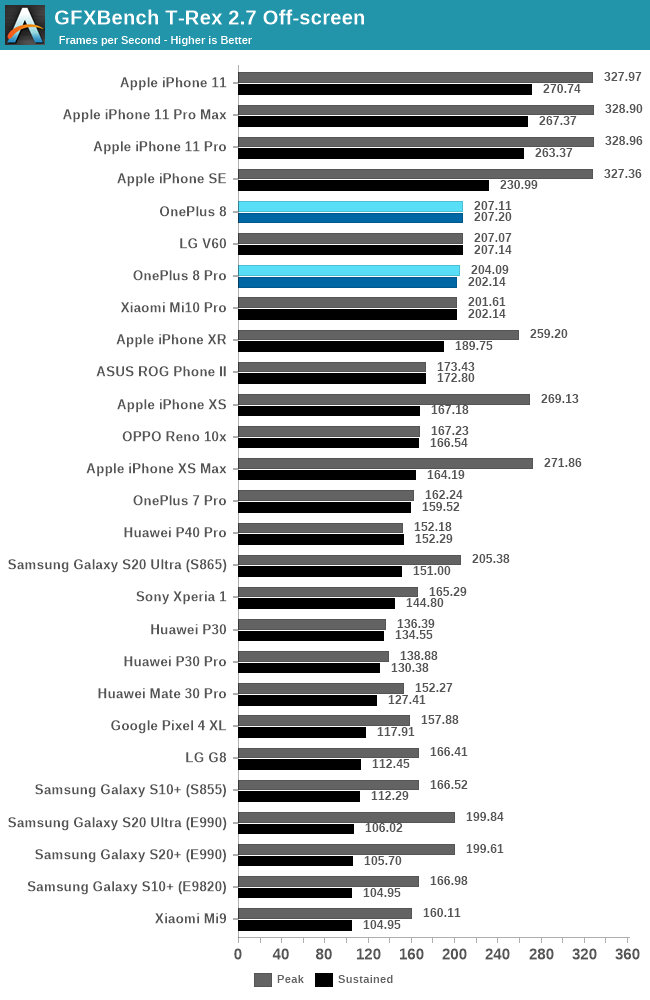
The same characteristic of both OnePlus phones having essentially matched peak and sustained performance figures is essentially mimicked in all other GFXBench tests. Again, this comes at a contrast of our first impression of the Snapdragon 865 that we tested in the S20.
I’ve since then also been able to test the LG V60 and the Xiaomi Mi 10 Pro to have a wider repertoire of Snapdragon 865 phones and all of them seem to perform similarly to the OnePlus 8 and OnePlus 8 Pro, showcasing excellent sustained performance characteristics.
The OnePlus 8 phones had excellent thermal behaviour during the stress tests, with the phone never exceeding ~37-38°C peak skin temperatures which points out to fantastic heat dissipation from the SoC to the whole phone body.
These new test results finally give meaning to Qualcomm’s initial claims of excellent thermal behaviour of the new chipset and that it is able to indefinitely maintain its peak performance. Both OnePlus 8 phones are able to materialise this claim and will have no issues with providing excellent performance in games.
Display Measurement
The OnePlus 8 and 8 Pro feature brand new display panels that represent the best in their respective categories. Since the OnePlus 7 Pro, the company has been able to source amongst the best and cutting-edge panels from Samsung, and the OnePlus 8 Pro is no different. Using the latest emitter technologies, a 1440p resolution and a 120Hz refresh rate, there’s very little to be wished for in the display of the new flagship.
The OnePlus 8 has an equally excellent screen, however with its 90Hz and 1080p resolution is just shy of having the best specifications.
We move on to the display calibration and fundamental display measurements of the OnePlus 8 and OnePlus 8 Pro screens. As always, we thank X-Rite and SpecraCal, as our measurements are performed with an X-Rite i1Pro 2 spectrophotometer, with the exception of black levels which are measured with an i1Display Pro colorimeter. Data is collected and examined using Portrait Display's CalMAN software.
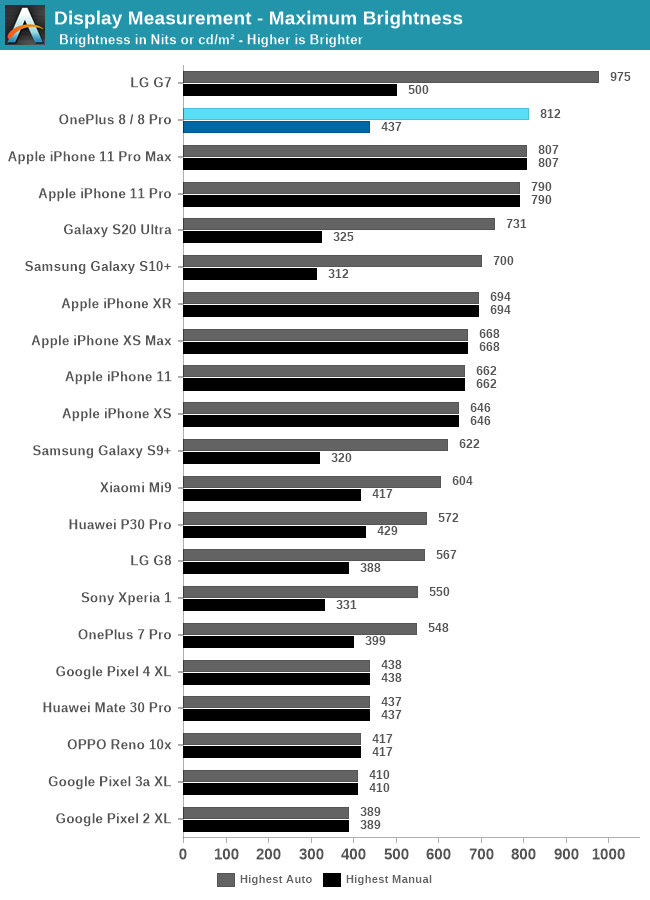
In daylight, both phones have excellent brightness reaching up till around 800nits on full-screen white content, representing the best results we’ve measured on an OLED panel, just shy of the LG G7’s ultra-bright LCD screen. Under manual brightness the phone reach about 430 nits.
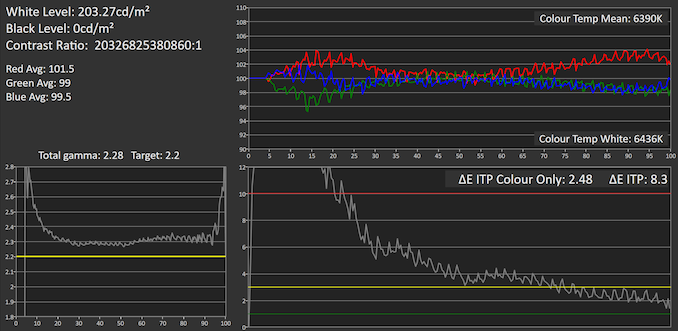
 Portrait Displays CalMAN
Portrait Displays CalMAN
OnePlus 8
On the regular OnePlus 8, the phone has good colour temperature although the reds are only every so slightly above a perfect grade. The display’s gamma curve however is a tad more off with too high a total gamma of 2.28, making tones appear darker than they should be. This seemingly is especially present in the lower intensity tones as the phone clips a lot of content to black or near-black.
The zig-zagging measurement results here are pointing out to some sort of artefac of the screen calibration which is a bit abnormal, but something we did see on occasion happen on some devices in the past.
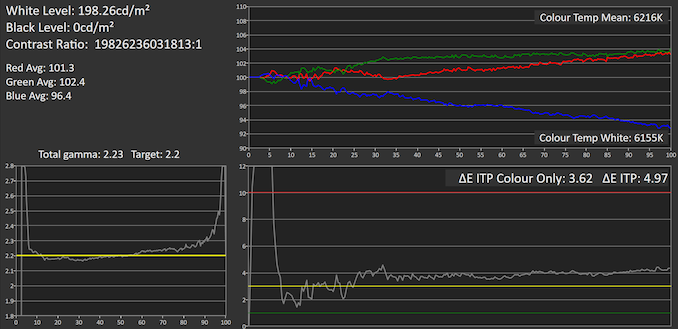
 Portrait Displays CalMAN
Portrait Displays CalMAN
OnePlus 8 Pro
On the OnePlus 8 Pro, the gamma results are significantly better and the phone is able to track nearer to the optimal 2.2 target. The 8 Pro’s biggest issue though is colour balance as in the natural profile things are far too much dominated by reds – or rather say a lack of blue. The average colour temperature ends up at 6216K and pure whites end up in a quite disappointing 6155K which is pretty much immediately visible on the phone.
sRGB saturation accuracy of the OnePlus 8 is quite good and we end up with an overall dEITP of 2.75 which is within the imperceptible margin for most users.
The OnePlus 8 Pro’s colour accuracy isn’t nearly as good. We’re seeing worse results across the board and when looking at the gamut results this seems to be due to too weak blue tones, shifting the whole cyan-blue-magenta saturations from where they should be. The most noticeable effect of this is again in whites where they’re far too warm.
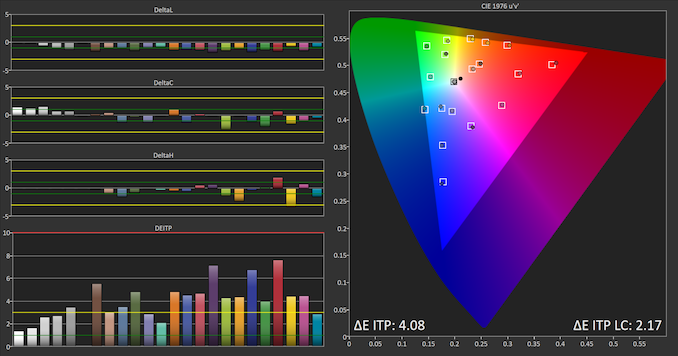
 Portrait Displays CalMAN
Portrait Displays CalMAN
OnePlus 8
In the Gretag MacBeth colour chart with most common tones and skin colours, the OnePlus 8 fares well in terms of its colour accuracy, only being more handicapped by its higher gamma target which makes all tones appear darker than they should be. Overall, it’s still an excellent result for the phone.
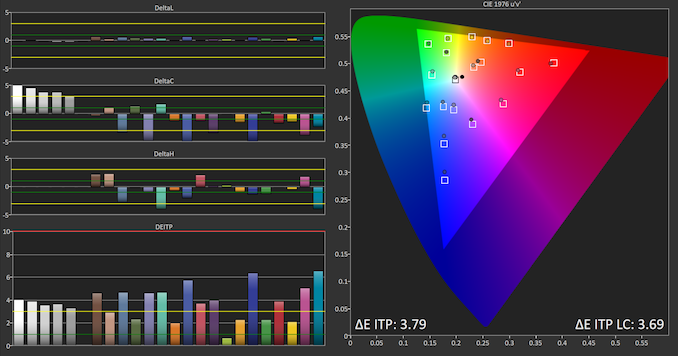
 Portrait Displays CalMAN
Portrait Displays CalMAN
OnePlus 8 Pro
The OnePlus 8 Pro nails the luminance component of the test patches, however it has more significant hue and saturation deviations that more easily stand out to the eye
Overall Display Conclusion
Both the OnePlus 8 and 8 Pro have excellent displays. The 90Hz and 120Hz refresh rate capabilities of the phones is what really makes them stand out in everyday usage. In terms of colour accuracy, things aren’t at all perfect. The OnePlus 8 has issues with the gamma curves, having a too high target resulting in too dark tones, especially at the lower intensity levels where things can clip to black.
The OnePlus 8 Pro’s issues are more severe as whilst its gamma is good, it has more noticeable problems with some hues and especially saturations in the blue spectrum. The biggest issue is its far too warm colour temperature with whites falling in at only 6150K. OnePlus likes to brandish awards regarding the device’s screen accuracy, but legitimacy of such figures always come in question as such cherry-picked results never match proper independent analysis. Nevertheless, you can set up a manually adjusted colour temperature that will solve the main negative about the screen.
Battery Life
Battery life of the OnePlus 8 Pro was a big question-mark for a lot of users given the phone’s 120Hz refresh rate. Several weeks ago I had reported on my initial power draw investigation results covering the different display modes of the screen:
Much like on the Galaxy S20 series, the OnePlus 8 Pro incurs a large static power draw penalty when switching from 60Hz to 120Hz. This is a increase in the baseline power of the phone, no matter the type of content that you’re displaying, and will even incur on a pure black screen.
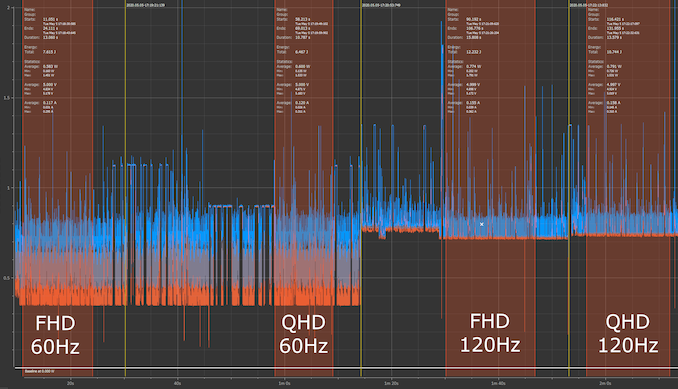
OnePlus 8 Pro Baseline Power usage (Black Screen)
Whilst OnePlus does include refresh rate switching mechanisms based on scenarios such as video playback, the lack of a true variable refresh rate (VRR) mechanism that works on the per-frame basis and is implemented on the deeper OS and GPU driver levels, means that current generation high-refresh rate devices will have to suffer from a larger than usual power and battery life penalty.
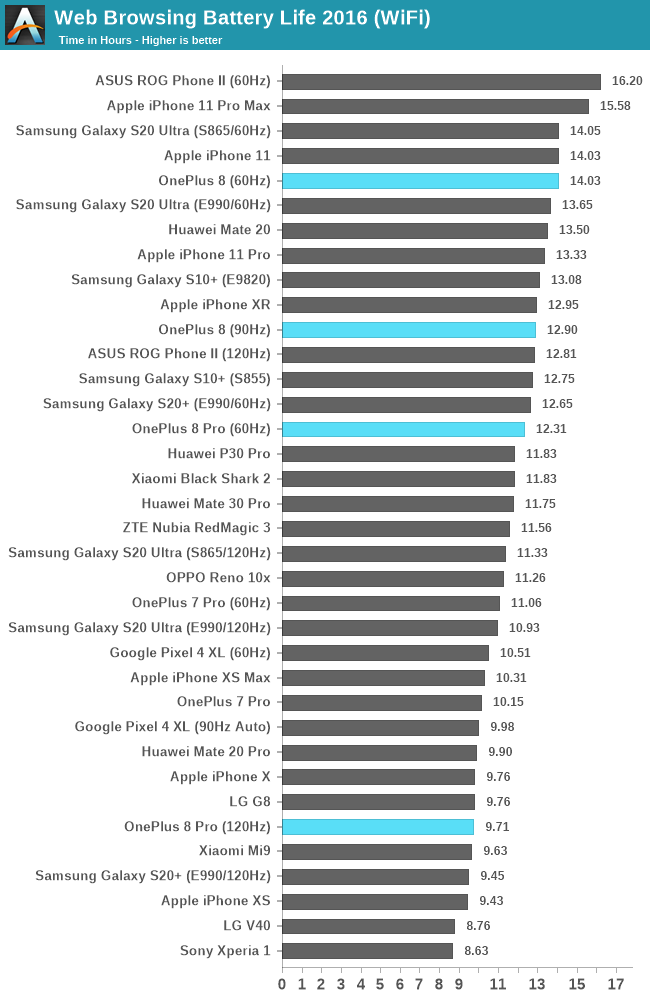
In our web browsing test, we see the clear impact of the 120Hz refresh rate on the OnePlus 8 Pro as it reduces the battery life of the phone in the test by 22% compared to its regular 60Hz mode. As a note- we’re testing at QHD resolution here as generally there’s very little power benefit from using lower resolutions.
In terms of absolute results, the 9.71h of the 120Hz mode here are adequate but not great. The results fall in line with the S20+ at 120Hz, but short of the bigger battery capacity of the S20 Ultra. At 60Hz, the 8 Pro moves back in at 12.31h which is a great result and will get you through even the most extensive usage days.
Whilst many will have looked forward to the OnePlus 8 Pro results, the really interesting results belong to the smaller OnePlus 8. The phone here was able to showcase outstanding battery life figures. The 90Hz mode only has an 8% impact on the battery runtime in this test, and in the 60Hz mode the phone lasted for a staggering 14h which is amongst the best results we’ve ever measured on a phone.
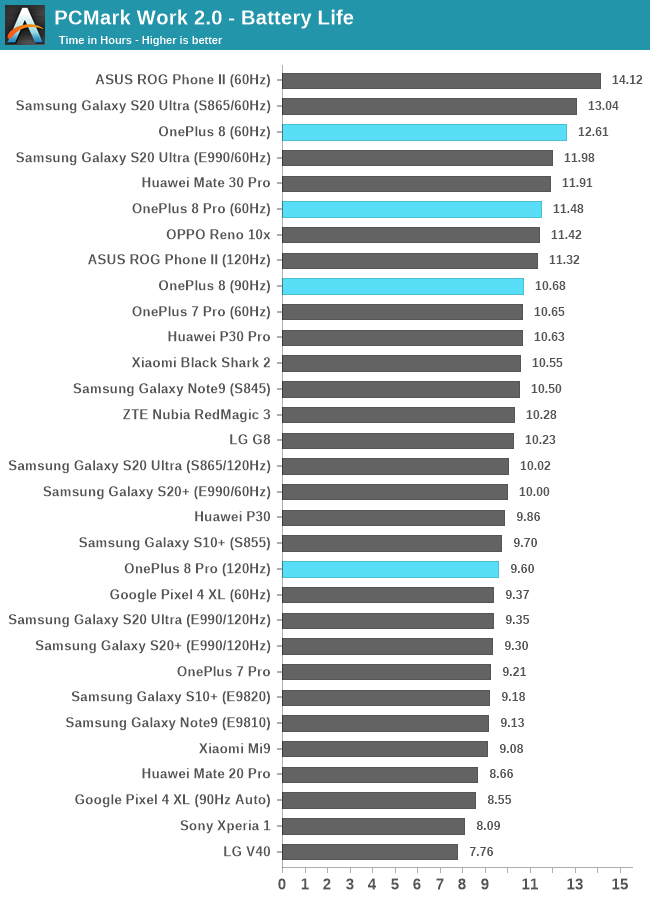
In PCMark, the smaller OnePlus 8 again takes the lead in terms of longevity with its 60Hz mode. The 8 Pro also does quite well at 60Hz, and both phones lose respectively 15.4% and 16.4% of their runtime when switching over to 90Hz and 120Hz modes.
Whilst the OnePlus 8 Pro pretty much fell in line with what we’ve expected in terms of its battery life, falling in line with the 120Hz power behaviour of the S20 phones, it’s the regular OnePlus 8 which surprised a lot given that it features a slightly smaller battery, notably surpassing the efficiency of the OnePlus 8 Pro. Given its form-factor and weight, it’s easily the longest-lasting device of its class, with only other heavier, bigger battery phones being comparable in terms of battery longevity.
Camera Recap - Amongst The Best
Last week, we published a more extensive dedicated camera article comparing a larger swath of recent flagship devices that have been released in last few months, including the new OnePlus 8 and OnePlus 8 Pro. I would suggest reading that piece for a more extensive camera analysis of not only the OnePlus 8’s, but also put in better context against its closest competitors:
Read Our Extensive Camera Evaluation For More Samples:
Mobile Flagship Phone Camera Overview 2020 H1: Still Picture Battle
I’ll quickly go over the key characteristics of the two phones in a few samples here:

[ OnePlus 8 ] - [ OnePlus 8 Pro ]
[ iPhone 11 Pro ] - [ iPhone SE ] - [ Pixel 4 ]
[ Galaxy S20U(S) ] - [ Galaxy S20+(E) ]
[ V60 ] - [ Mi 10 Pro ]
[ Mate 30 Pro ] - [ P40 Pro ]
[ Reno3 Pro 5G ] - [ Reno3 Pro ]
[ X-T30 ]
Between the 8 Pro and the regular 8, it’s generally evident that the 8 Pro has the better picture quality thanks to better detail retention and more dynamic range. The phone’s processing is generally amongst the best and competes with Samsung and Apple in terms of handling of tones, although the OnePlus phones more often seem to miss having the better exposure handling, such as in the above scene where both phones are flattening the highlights too much.
In terms of the phones’ main camera 48MP capture modes, it’s the 8 Pro that is the clear winner as the bigger pixels of the superior sensor are able to capture and retain more fine details.
A negative for the phone’s camera processing is that OnePlus continues to apply an artificial darkening filter on the shadows, whilst this increases the contrast of the scenes, it creates unnatural images with elements that nearly clip to black, something that had been introduced last year on the OnePlus 7 Pro as an attempt to copy the Pixel 3’s look – which Google ironically had fixed this aspect on the Pixel 4.
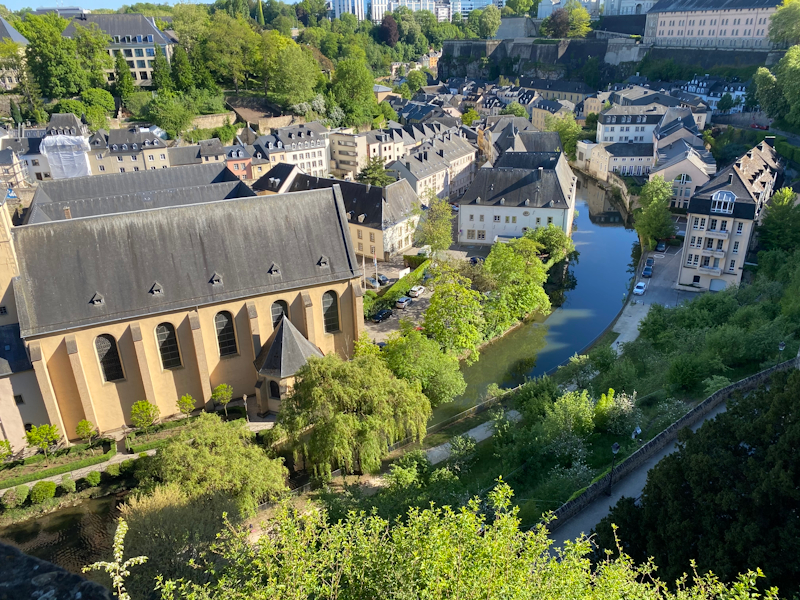
[ OnePlus 8 ]
[ OnePlus 8 Pro ]
[ iPhone 11 Pro ] - [ iPhone SE ] - [ P4 ]
[ Galaxy S20U(S) ]
[ Galaxy S20+(E) ]
[ V60 ]
[ Mi 10 Pro ]
[ Mate 30 Pro ]
[ P40 Pro ]
[ Reno3 Pro 5G ]
[ Reno3 Pro ]
[ X-T30 ]
In terms of telephoto photography, the OnePlus 8 Pro notably is the better phone as it features a dedicated camera module for this task, whilst the OnePlus 8 has to make due with digital cropping, although it’s not as bad thanks to the switch to the camera’s switch to their native 48MP modes.
In the ultra-wide photos, the OnePlus 8 Pro is again the clear winner thanks to its hardware advantages, achieving better details and dynamic range. Both phones are able to showcase good results, although colours aren’t as realistic as on Apple’s and Samsung’s ultra-wides.
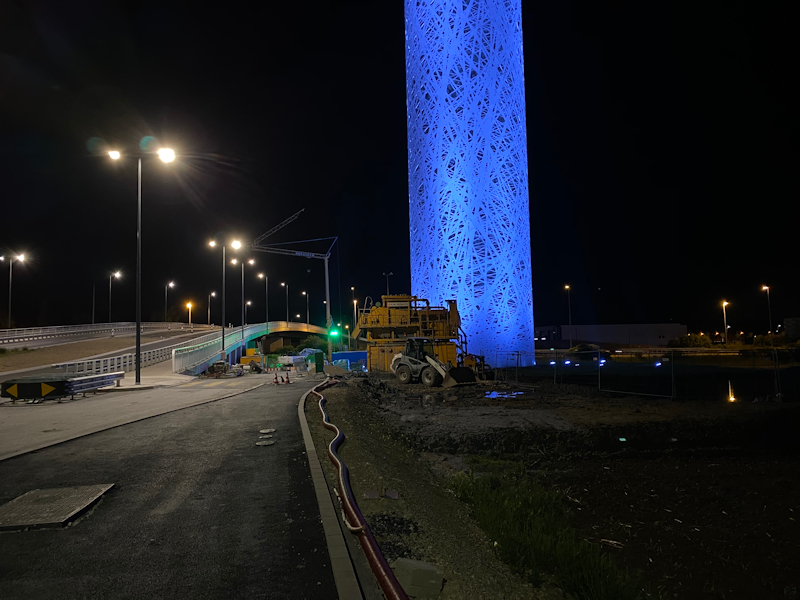
[ OnePlus 8 ]
[ OnePlus 8 Pro ]
[ iPhone 11 Pro ] - [ iPhone SE ] - [ Pixel 4 ]
[ Galaxy S20U(S) ]
[ Galaxy S20+(E) ]
[ V60 ]
[ Mi 10 Pro ]
[ Mate 30 Pro ]
[ P40 Pro ]
[ Reno3 Pro 5G ]
[ Reno3 Pro ] - [ X-T30 ]
In low-light photography, OnePlus has been able to make major leaps forward in terms of quality thanks to improved software processing. It’s especially the OnePlus 8 Pro which has the quality lead as the phone’s superior camera sensor showcases a clear advantage to that of the OnePlus 8. In fact, the OnePlus 8 Pro consistently fared as amongst the best performers in low-light photography now, sometimes ending up as the top performer thanks to its excellent new Nightscape implementation.
The 8 Pro’s comparatively large ultra-wide module sensor also means that it’s amongst the best performers in low-light, only being beaten by the even larger sensors of Huawei devices.
One aspect we didn’t cover in our camera comparison article was the OnePlus 8 Pro’s “colour filter camera”. First of all, OnePlus did an absolutely abysmal job in actually describing the technical aspects of this camera and what it actually does. Although switching to this camera module is amongst the colour filter options in the camera UI, its effects are anything but a filter.
Any camera sensor and module on any device out there is able to capture infra-red light by default – it’s just that usually to limit the wavelengths that it sees to that of a human eye, vendors employ an IR blocking filter layer between the camera sensor and the optics. In the OnePlus 8 Pro, this layer is missing, and thus this extra camera module is able to actually capture infrared wavelengths. In fact, hobbyists out there even actively modify their digital cameras to remove this filter to achieve IR photography.
The fact that OnePlus hasn’t been able to explain the technical details of this module in their marketing materials is extremely unfortunate as there’s been a ton of misunderstanding as to what it actually does – even going so far that there’s been a backlash with privacy concerns as the camera can see through some materials that are transparent to IR light but opaque to visible light, with OnePlus even saying they’ll be removing the feature in a software update. I no longer have the phone so I don’t know if it’s actually been disabled or not, but I do find it a pity if it’s gone as it was able to achieve some very unique pictures, especially of vegetation in sunlight.
Read Our Extensive Camera Evaluation For More Samples:
Mobile Flagship Phone Camera Overview 2020 H1: Still Picture Battle
Overall, the OnePlus 8 Pro and OnePlus 8 are both good camera shooters. The regular OnePlus 8 doesn’t convince as much as its hardware disadvantages are clearly limiting what it can achieve. In this regard, the pictures it’s able to produce are adequate but it has trouble compete with the quality of the competition.
The OnePlus 8 Pro is a much better choice if you value the camera experience. OnePlus has made big leaps in the processing and picture quality. In daylight it competes with Apple and Samsung – although I still do think the phone’s shadow handling is too artificial an unrealistic – but that’s a subjective opinion. In low-light, thanks to the new processing and upgraded sensor hardware both on the main sensor and the ultra-wide camera, the OnePlus 8 Pro consistently is amongst the best performers in low-light. Overall, the 8 Pro delivers an excellent camera capture experience that’s plenty versatile.
Video Recording
Next up, some video sample comparisons between both phone’s different modules and capture modes.
OnePlus 8 Pro
OnePlus 8
Starting off with the colour renditions of the scene, both phones do ok but I feel that there’s something off with the tone curves as things either look a bit too oversaturated or some highlights are being flattened too much? It’s a weird look that more present on the main sensor of the 8 Pro than on its ultra-wide or on the regular 8. Both main camera sensors suffer from lens flaring in the sun, but the 8 Pro here is especially predominant compared to its other two camera modules.
Switching between the modules is fast when zooming in and out – naturally the regular OnePlus 8 doesn’t have a telephoto module so zooming in beyond 2x comes at a great loss of quality as it’s just digitally cropping the frame.
Electronic image stabilisation works great on both phones. Switching over to 60fps recording disables EIS and here we can see the OIS performance of both phones. The OnePlus 8 Pro has a significantly better stabilisation as the OnePlus 8 becomes quite a lot shakier.
OnePlus is still pretty nuts in regards to the video bitrate at 60fps as for a H.264 recording we’re jumping from 50Mbps at 4K30 to a whopping 160Mbps at 4K60, resulting in file sizes exceeding 1GB per minute. The quality is outstanding of course, but it far exceeds what you’d be able to upload and view on any video platform such as YouTube. I wish OnePlus would give the option to scale this down in its camera app as it’s a bit overkill for most use-cases.
 OnePlus 8 Pro - 4K30
OnePlus 8 Pro - 4K30

OnePlus 8 Pro - 4K30 HDR
Dynamic range can be an issue in bright scenarios, and the OnePlus 8 Pro offers HDR recording. This actually means it’s an HDR processed capture in an SDR recording. In the above frame captures between the two phones we see that this gives a significant boost to shadows and the effective dynamic range of the scene. Unfortunately, the phone is only able to record in this mode on its main camera module, and it’s not available on the regular OnePlus 8. I also noticed that the phone has big troubles focusing while in this mode.
Audio recording was recording on both phones, but there was wind noise present in both, but particularly prominent on the regular OnePlus 8.
Overall, I’d say video recording quality and experience on both phones is good, but the OnePlus 8 Pro is the clear winner, with the ultra-wide-angle recording experience in particular being the best.
Conclusion & End Remarks
As we’re coming to and end of the review, the biggest question for both the OnePlus 8 and OnePlus 8 Pro is whether they’re devices worth buying.
Design-wise, I really do like what OnePlus has done with both variants. On the OnePlus 8 Pro I’m happy that they dropped the pop-up camera module in favour of a hole-punch front camera setup. Whilst this abandons the seamless full screen experience, the phone is able to gain on internal component spaces that goes to the batteries and cameras and it also gains IP68 certification – all whilst losing weight compared to its predecessor.
I really loved the ergonomics of the smaller OnePlus 8 and this has been easily my favourite form-factor and the best feeling device of the past few years. The symmetrical curves on the front and back glass are a better implementation than the more pronounced display curvature of the OnePlus 8 Pro. We’ve seen other vendors revert on their screen curvature choices and I think OnePlus would also require such a design adjustment in the future.
If you’re opting to get one of the phones – chose one with the matte frosted glass finish. It not only avoids fingerprints a lot better than glossy glass, but it also feels and just looks better. Overall, I think OnePlus did an excellent job on the design of the phones.
The displays of the phones are both fantastic, although obviously the regular OnePlus 8 has lower specifications, going only up to 1080p and 90Hz. The OnePlus 8 Pro’s QHD 120Hz display looks and feels amazing – there’s very little to critique about the phone other than maybe its colour calibration which really wasn’t up to par on my review sample. OnePlus here should spend less on the marketing side and more on the engineering and quality assurance side of things.
Performance of both phones is top-notch, although it’s just in line with other Snapdragon 865 devices. The OnePlus 8 Pro’s 120Hz mode outstanding for scrolling content, and is just second to the S20 series in terms of snappiness. We’ve tested a slew of different new Snapdragon 865 phones recently and they’ve all shared in common excellent GPU sustained performance and thermal characteristics, essentially showcasing no slowdown at all during prolonged usage periods, making the OnePlus 8 and 8 Pro amongst the best Android gaming devices on the market right now.
Battery life was surprising in that the regular OnePlus 8 exceeded our expectations, testing in amongst the longest lasting devices in our mobile suite. The OnePlus 8 Pro’s battery life wasn’t as good – as expected and matching the characteristics of the Galaxy S20 phones, the 120Hz display comes at a great cost to battery life as the software ecosystem just isn’t ready for true variable refresh rate operation.
The OnePlus 8 at 90Hz actually outperformed the OnePlus 8 Pro at 60Hz – and the difference grows to a 32% lead when comparing the two phones in 90Hz vs 120Hz modes. That’s a tough compromise to make given that the smaller phone has a smaller battery – although yes you do get a higher resolution screen and higher refresh rate experience that is indeed noticeable.
On the camera side of things, the regular OnePlus 8 is good – but I wouldn’t quite say it competes quite as well in the flagship segment against the competition. The OnePlus 8 Pro on the other hand easily has a flagship class camera system that not only holds up well with the competition, it even manages to beat them in some aspects such as low-light photography. It’s not a perfect camera system and OnePlus still has to work on their processing, but it’s the best camera experience that the company has ever been able to showcase to date.
In the end, the question of whether the new OnePlus 8 phones are worthy purchases comes down to their prices. Starting with the OnePlus 8 Pro – I think the phone’s starting $/€899 price point the phone easily competes against its closest competitor, that being the S20+. It’s an extremely tough toss-up in almost all aspects of the two phones which is a testament to the fact that the OnePlus 8 Pro is a true flagship device. If you’re in an Exynos market – the OnePlus 8 Pro’s Snapdragon 865 chipset is the obvious choice for better performance and battery life. In the US, the obvious value choice goes to OnePlus again as here we’re still seeing a $300 price gap – with very little compromises in terms of features or quality.
For the OnePlus 8 which starts at $/€699, there’s actually very little competition out there at this price range when what you’re looking for is performance and battery life – as the phone fully delivers and excels on both those aspects. The camera system doesn’t quite match up to an S20 for example, but it also undercuts the S20 by 100€ in Europe. In the US where the S20 is still $999, the differences (QHD screen, 120Hz, wireless charging) between the phones are more easily rationalised by their larger pricing gap.
Overall, I can easily recommend both OnePlus 8 phones – and I don’t think anybody would be disappointed with their purchases. OnePlus was able to produce excellently balanced devices in terms of quality and features as well as their value propositions, and so far, have been a highlight of 2020’s smartphone line-up.

